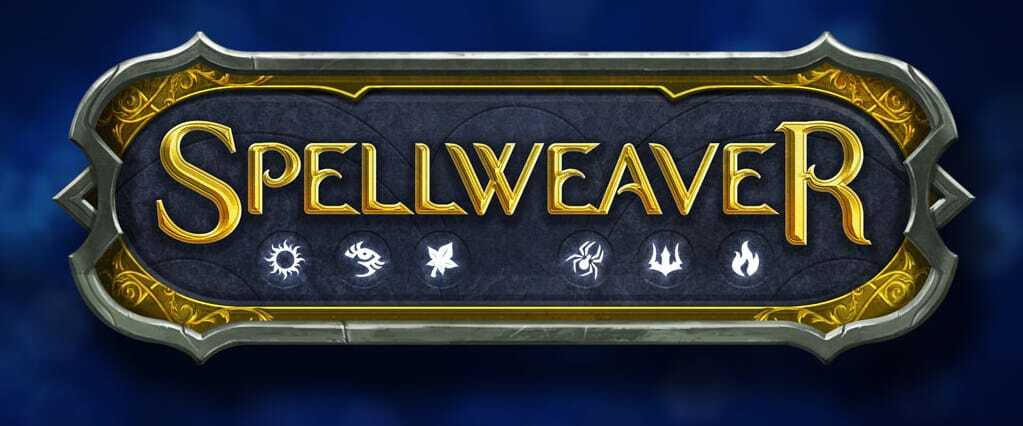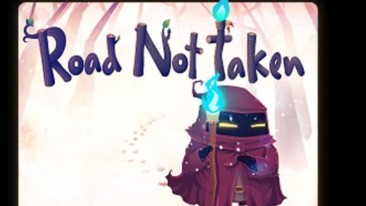Spellweaver: What We Think
Spellweaver by Dream Reactor LLC is a new digital card collecting game entering the arena at a time when the genre is fast becoming as saturated as RTS games were in the late 90s and early 2000s. It does, however, do some interesting things that set it apart and even improves upon some old concepts.
Spellweaver’s closest spiritual cousin is the granddaddy of all CCGs, Magic: The Gathering. All the familiar concepts are present, from summoning sickness to using land cards to draw Mana, to ‘tapping’ as a means of activating a creature ability (as “exhausting” in this game). Even some creature abilities such as “First Strike” and “Trample”–“called Ranged” and “Unstoppable”–make appearances here. So if you’re familiar with Magic, you’ll have no problem picking this game up and playing without even a second spent in the tutorial.
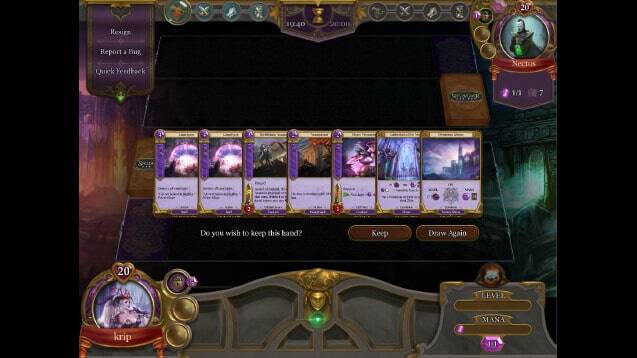
This Spells Trouble
The game differs from its spiritual predecessor in some really intriguing ways. The most noticeable change is how Mana levels are built up versus abilities requiring color costs. In Magic, you would play your Land card, and it would stay on the table, generating one point of a colored Mana for you. In Spellweaver, when you draw your Land equivalent–“Shrines”–you have a couple of options. First, you can play it as a Level Up for the color of magic it provides. Cards in Spellweaver have not only a Mana cost, but a level requirement to cast them.
Unlike Magic, which requires different colors of Mana for different cards, all Mana in Spellweaver is generic and colorless; you just have to build up some levels to enable the casting of more powerful spells, which is a good way to stagger growth in a match. For those unfamiliar with this concept in card games, this is often called “ramp,” as it’s a secondary requirement beyond the flat Mana cost which is designed to keep players from simply playing the most powerful spells as early as possible.
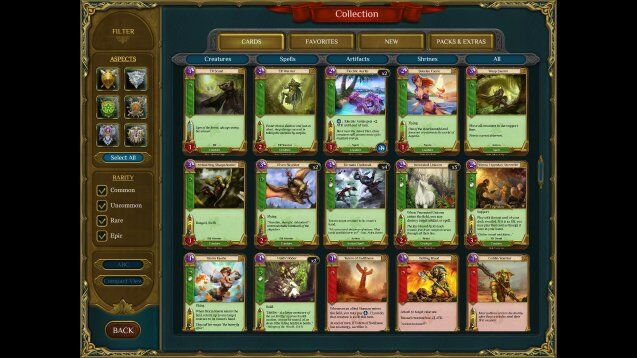
Draw From Deep Within
The second option for your Shrine play is that you may simply turn it into Mana that becomes ready to use every turn. Note that the difference here is that you will find getting a level in a color of magic does not provide any actual Mana for casting your spell cards; it just gives you access to use them.
When you drop a Shrine for Mana, however, you get the secondary benefit of drawing an extra card to replace it. This card draw dramatically distinguishes the game from other CCGs. Without this card draw bonus, having a lot of Mana in your deck meant slowing your deck down, making it weaker against players who run fast, cheap decks. The added draw keeps you in the game, allowing you to compete against fast decks even if you are running a bigger deck that ramps up slowly. By accident, this also solves the problem of a massive, useless Mana clump.
It doesn’t hurt your late game to draw a shrine card when you wanted a spell to save you. You can still play the card as Mana and redraw a new card. The amount of positive effects this minor change creates during play solves one of the biggest issues I’ve had with Magic after getting used to gaining one extra Mana per turn, a device with which (Blizzard Entertainment’s) Hearthstone has spoiled us. Then there is the dynamic of choice when deciding if you want more Mana, letting you play more, or an extra level, giving you access to more of your deck.
Shrines also provide an additional function. Rather than a replacement card draw, some rarer Shrines will grant you an ability that becomes a spell you can always use (albeit with a cool-down period. In this way, you are given a spell you can cast from a sidebar–not from your hand–any time you wish. This is similar to the Hero Abilities in Hearthstone, but the cool-down of more than a single turn better balances them.
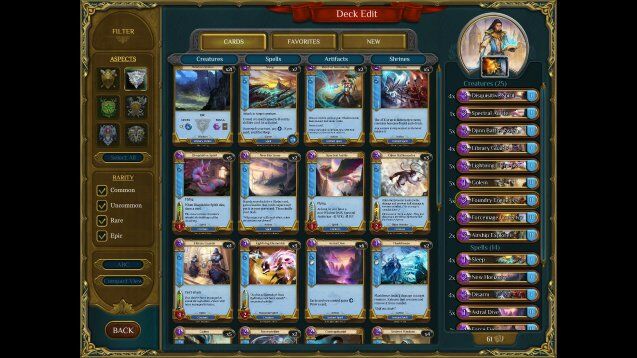
Pick Your Pointy Hat
When you begin deck-building, you will start with a wizard, each of which comes with each their own innate ability. Each color of magic has a selection of two wizards, but outside of starter packs, you’ll still need to draw that second wizard out of an expansion to get access to it. Still, once your collection has become bigger, you’ll eventually have 12 basic abilities to choose from.
Deck building is exactly like in Magic: a maximum of four of any one card, a suggested third of the deck should be Shrines, and multi-color decks are encouraged to cover weaknesses. The themes for the colors are also mostly similar to Magic other than with blue, and the new color, purple. Purple is domination magic and feels like a mix of Magic’s black and blue colors, with a lot of control and some self-destruction for quick power.
Blue, however, covering air spells, has the majority of one of Spellweaver’s other unique contributions to the playing field. Many blue cards carry with them Energy counters which can be built up and spent for other effects. There are also a lot of spells that manipulate this extra resource, giving you more of it or providing some other buff just from having a lot of blue cards.
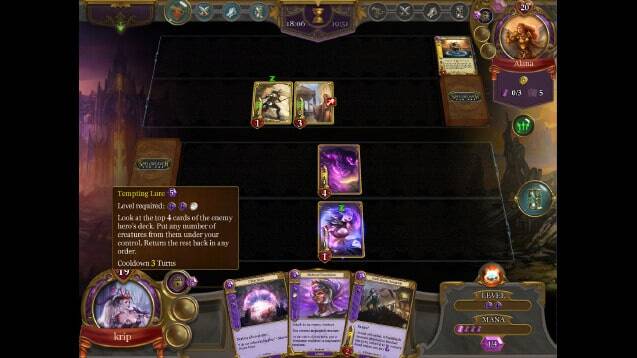
Spellweaver’s play field is broken up into two areas per player. These areas are your front line and your support line. Most of the time when you summon creatures, you’ll want to put them in your front line, as your units can only attack or defend from there. The strategy begins when you notice that your character cards have not two stats, but three! In addition to their attack and defense, the third stat reflects its speed. When you attack your opponent with a creature, it can only be blocked by your opponent’s creatures who have an equal or higher speed stat. This means if you only have big fat slow creatures, you can be tagged by faster creatures without any option of blocking at all.
Another option is to attack a player’s creatures directly, should their speed be matched or slower than yours. Your opponent can then intercept that attack with yet even more of their creatures, should their speed allow them. Basically, when the attack phase begins, don’t count your chickens until all eggs have been placed, counter-placed, intercepted, blocked, kicked to the back row, killed, etc.
Now Just The People In the Back!
The presence of a support row shakes up the CCG formula as well. Creatures in the support row can’t attack or defend (unless they can fly!), but they are also protected from direct attacks from your opponent. This allows you to keep some creatures with pure utility abilities safe…mostly. By this same reasoning, you’ll want to give your decks some decent cards that will work on supporting creatures as well.
That’s Spellweaver in a nutshell! Anything else is window dressing; as for any good card game, mechanics are king.
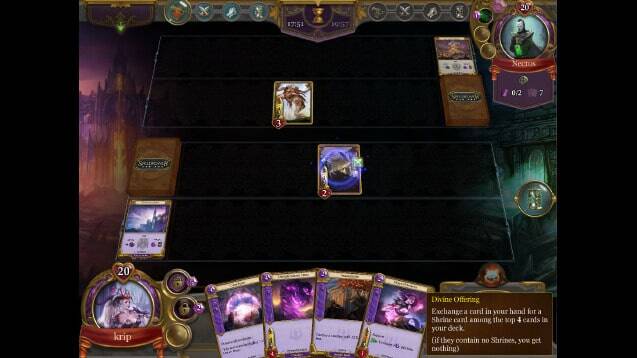
Everything In Its Place
The in-game UI is very functional. Everything is where it should be, button layouts are intuitive, and things are easy to read. My only wish would be that some of the buttons stood out a bit more or were a bit larger; when attacking with your characters, an obvious line is drawn to its intended target. These lines are curved as an arch, so there is never any confusion as to who is attacking what, and what is being blocked by whom.
As your opponent assigns blockers, each group is separated from each other, so it’s clear where the fights are and where the damage is coming and going. Big red icons show basic status effects on cards that are unable to attack or block as well as other color-coded icons showing basic creature abilities without having to zoom in on the card to read the card text in detail.
Card effects, however, are still very limited, and as stated when you boot the game up, “not final.” There are a couple of fireball effects currently in use, but the majority of effects you’ll see, at least while the game is still in beta, are cards lifting off the tables to slam into their targets during the attack phase. Again, what is in there now is just the beginning of what’s to come, but getting more “snap” to your cards would be satisfying. Otherwise, card effects with cards flying across the table or into or out of the draw deck or graveyards show nicely where cards are going when being manipulated by spells.
One important effect I found missing at this phase of Beta, however, was a shuffle animation. I sometimes found myself wanting to know if pulling a few cards from the top of my deck led to the rest of it getting shuffled or not and not really knowing until I drew my next card.
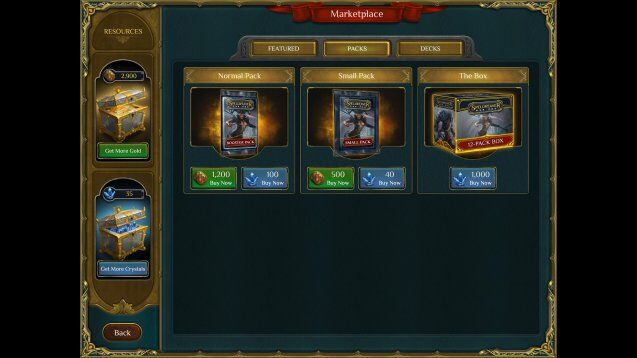
As for how it handles micro transactions, Spellweaver appears to be fairly generous with its card boosters. With the help of a few familiar types of daily quests, you can earn enough credits for an eight-card standard pack after roughly 10 games. If purchased, these packs will set you back $2 USD per pack. New starter decks with much of what you need to get started on a new color of magic can be gained from both cash and in-game coin, neither asking for an arm or a leg, just enough to keep you invested without cutting the bottoms out of your pockets. You can also supplement a specific color with a pre-made set of cards to give you more options in a single color if you don’t want to risk getting cards you’re not interested in from standard booster packs.
Weave Some Time Aside For This One
Likely, the deciding factor for this being a game worth its required time commitment and your precious dollar will come down to how big the player base gets. Being in closed beta right now, the player counts have been hovering around 50 in the middle of the night, and upwards of 150 to 200 during the day. Seeing that those are simultaneous users and that this closed beta has been very much under the radar, it’s actually fared really well.
Once open beta drops like a ton of bricks, and word gets out that this game plays much more like Magic: The Gathering than any other current PC CCG, this title could be a winner! With about 200 cards in the pool split across six schools of magic, they’ll want to come out with some expansions fairly quickly (perhaps for launch out of beta?), but having the freedom to mix schools of magic as freely as you wish will keep even a fairly limited release fresh for some time.
Spellweaver TCG – official site
Spellweaver TCG on Steam Greenlight
Closed Beta Rating:
[xrr rating =”4/5″]
Watch the trailer for Spellweaver TCG below:


